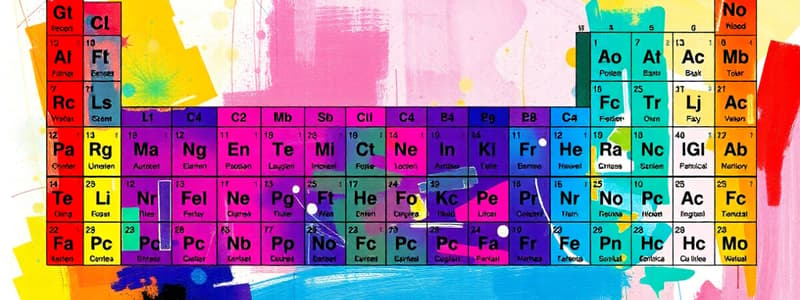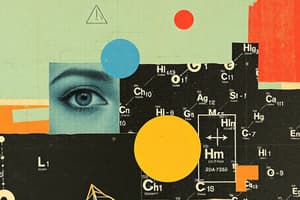Podcast
Questions and Answers
What is a family in the context of the periodic table?
What is a family in the context of the periodic table?
- An element with a full outer shell.
- A column of elements with similar properties. (correct)
- An element that tends to lose electrons easily.
- A row of elements with similar properties.
What defines a period on the periodic table?
What defines a period on the periodic table?
- A vertical column of elements.
- Elements with the same atomic mass.
- A horizontal row of elements. (correct)
- Elements that share the same number of valence electrons.
What is the correct atomic symbol for silver?
What is the correct atomic symbol for silver?
- Ag (correct)
- Sl
- Si
- Au
Which element corresponds to the atomic number 17?
Which element corresponds to the atomic number 17?
Which of the following elements is classified as a halogen?
Which of the following elements is classified as a halogen?
What is the atomic mass of mercury?
What is the atomic mass of mercury?
What group number do Cu, Ag, and Au belong to?
What group number do Cu, Ag, and Au belong to?
Which of the following is an alkaline earth metal?
Which of the following is an alkaline earth metal?
What is the last element in period 4 of the periodic table?
What is the last element in period 4 of the periodic table?
Which of the following is a noble gas?
Which of the following is a noble gas?
What is the atomic number of Calcium?
What is the atomic number of Calcium?
What is the atomic mass of Iron?
What is the atomic mass of Iron?
How many protons does Gold have?
How many protons does Gold have?
How many electrons does Uranium have?
How many electrons does Uranium have?
Which element has more protons, Sulfur or Iodine?
Which element has more protons, Sulfur or Iodine?
Does Mercury have more electrons than Tin?
Does Mercury have more electrons than Tin?
Is Potassium heavier than Neon?
Is Potassium heavier than Neon?
Which of the following is the symbol for Silver?
Which of the following is the symbol for Silver?
What is the atomic mass of Uranium?
What is the atomic mass of Uranium?
How many neutrons does Carbon have?
How many neutrons does Carbon have?
Flashcards are hidden until you start studying
Study Notes
Periodic Table Basics
- A family refers to a vertical column in the periodic table, where elements share similar properties.
- A period is a horizontal row in the periodic table, indicating the number of electron shells around an atom's nucleus.
Element Symbols
- Magnesium symbol: Mg
- Potassium symbol: K
- Iron symbol: Fe
- Copper symbol: Cu
Element Names
- C: Carbon
- Cl: Chlorine
- Au: Gold
- Sr: Strontium
Period Classification of Elements
- He (Helium) is in Period 1.
- Ge (Germanium) is in Period 4.
- Rb (Rubidium) is in Period 5.
- I (Iodine) is in Period 5.
Group Classification of Elements
- Sulfur (S) is in Group 16 (Chalcogens).
- Ca (Calcium) is in Group 2 (Alkaline Earth Metals).
- Iodine (I) is in Group 17 (Halogens).
- Fe (Iron) is in Group 8 (Transition Metals).
Specific Elements by Characteristics
- Halogen: Chlorine (Cl)
- Chalcogen: Oxygen (O)
- Alkali metal: Sodium (Na)
- Boron: Boron (B)
- Lanthanide series: Neodymium (Nd)
- Alkaline Earth metal: Barium (Ba)
- Transition metal: Nickel (Ni)
- Noble gas: Neon (Ne)
Atomic Characteristics
- Atomic symbol for silver: Ag
- Atomic mass of mercury: 200.59 u
- Ni symbol represents Nickel.
- Element with atomic number 17: Chlorine (Cl).
- Two transition metal symbols: Cu (Copper), Ag (Silver).
- Group for Cu, Ag, and Au: Group 11.
- Two noble gases: Neon (Ne), Argon (Ar).
- Symbols for two halogens: F (Fluorine), Cl (Chlorine).
- Atomic number 74 corresponds to Tungsten (W).
- Atomic mass of copper: 63.55 u.
- Last element in period 4: Krypton (Kr).
Atomic Mass Calculations
- Oxygen (O): Atomic mass approximately 16, neutrons = 8 (16 - 8).
- Helium (He): Use periodic table for atomic number and mass.
- Carbon (C): Use periodic table for atomic number and mass.
- Aluminum (Al): Use periodic table for atomic number and mass.
- Calcium (Ca): Use periodic table for atomic number and mass.
- Sodium (Na): Use periodic table for atomic number and mass.
- Potassium (K): Use periodic table for atomic number and mass.
- Nitrogen (N): Use periodic table for atomic number and mass.
- Silicon (Si): Use periodic table for atomic number and mass.
- Iron (Fe): Use periodic table for atomic number and mass.
- Hydrogen (H): Use periodic table for atomic number and mass.
Element Protons and Electrons
- Calcium: Protons = 20, Electrons = 20.
- Gold (Au): Protons = 79, Electrons = 79.
- Copper (Cu): Protons = 29, Electrons = 29.
- Iron (Fe): Protons = 26, Electrons = 26.
Comparative Characteristics
- Mercury has more protons (80) than tin (Sn: 50) and thus more electrons as they are equal in number.
- Mercury is heavier than tin.
- Potassium has more electrons than neon; K has 19 electrons vs. Ne's 10.
- Hydrogen has fewer electrons than uranium (U), which has 92 electrons.
- Sulfur (16 protons) has fewer protons than iodine (53 protons).
Additional Element Symbols and Names
- Chlorine: Cl
- Zinc: Zn
- Copper: Cu
- Helium: He
- Potassium: K
- Iron: Fe
- Silver: Ag
- Phosphorus: P
- Sodium: Na
- Neon: Ne
- Tin: Sn
- Mercury: Hg
Studying That Suits You
Use AI to generate personalized quizzes and flashcards to suit your learning preferences.



